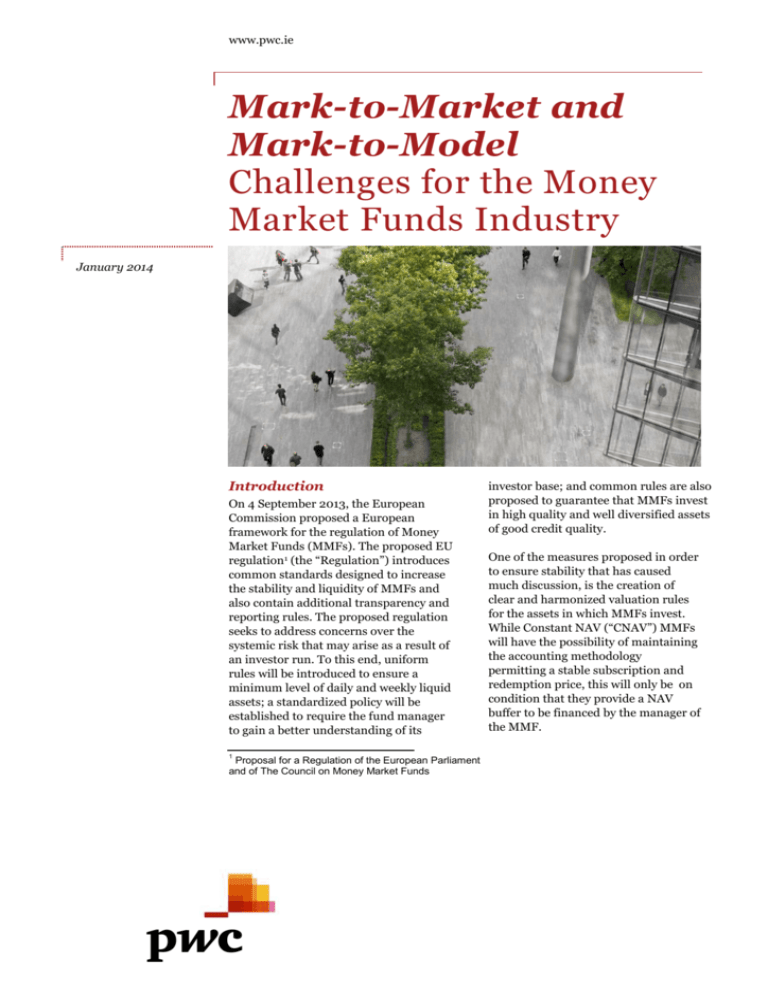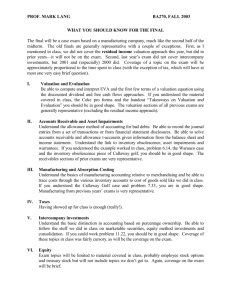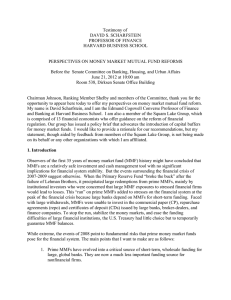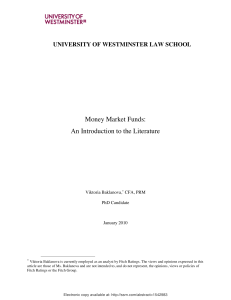
www.pwc.ie
Mark-to-Market and
Mark-to-Model
Challenges for the Money
Market Funds Industry
January 2014
Introduction
On 4 September 2013, the European
Commission proposed a European
framework for the regulation of Money
Market Funds (MMFs). The proposed EU
regulation1 (the “Regulation”) introduces
common standards designed to increase
the stability and liquidity of MMFs and
also contain additional transparency and
reporting rules. The proposed regulation
seeks to address concerns over the
systemic risk that may arise as a result of
an investor run. To this end, uniform
rules will be introduced to ensure a
minimum level of daily and weekly liquid
assets; a standardized policy will be
established to require the fund manager
to gain a better understanding of its
1
Proposal for a Regulation of the European Parliament
and of The Council on Money Market Funds
investor base; and common rules are also
proposed to guarantee that MMFs invest
in high quality and well diversified assets
of good credit quality.
One of the measures proposed in order
to ensure stability that has caused
much discussion, is the creation of
clear and harmonized valuation rules
for the assets in which MMFs invest.
While Constant NAV (“CNAV”) MMFs
will have the possibility of maintaining
the accounting methodology
permitting a stable subscription and
redemption price, this will only be on
condition that they provide a NAV
buffer to be financed by the manager of
the MMF.
Chapter IV of the Regulation deals with the valuation
of an MMF's investment assets and the calculation of
the MMF's net asset value per unit or share. Articles
26-28 contain rules on how a MMF should value
portfolio investments, calculate the net asset value
(NAV) per unit or share of the MMF as well as the
frequency of both sets of valuations. While there is a
general rule favouring mark-to-market and mark-to
model valuation techniques, MMFs offering a stable
NAV redemption profile (CNAV funds) may value
assets at amortised cost.
Currently all CNAV MMFs use amortised cost to value
the assets in their investment portfolios and many
Variable NAV (“VNAV”) MMFs also use amortised
cost to value portfolio investments with a maturity of
90 days or less. The proposed prohibition on the use
of amortised cost in the valuation of portfolio assets in
VNAF MMFs will have wide ranging implications for
such MMFs. This paper looks at the mark-to-market
and mark-to-model approaches that may be used to
value the financial instruments held by MMFs and
considers some of the limitations and weaknesses with
these approaches.
Determining fair value for MMF
Portfolio Instruments
Mark-to-market, sometimes known as fair value
accounting, refers to the accounting standards which
determine the value of a position held in a financial
instrument based on the current fair market price for
the instrument or similar instruments. Fair value
accounting has been a part of US Generally Accepted
Accounting Principles (“US GAAP”) since the early
1990s and came into the International Financial
Reporting Standards framework (“IFRS”) around
2000. The use of fair value measurements has
increased steadily, primarily in response to investor
demand for relevant and timely financial statements
that will aid in making better informed decisions.
IFRS 13 “Fair Value Measurement” which is the latest
standard within the IFRS framework dealing with the
measurement of fair value defines fair value as “the
price that would be received to sell an asset or paid to
transfer a liability in an orderly transaction between
market participants at the measurement date.” The
definition of fair value in US GAAP is consistent.
Broadly speaking, fair value can be estimated using
either (i) a quoted price in an active market (mark-tomarket) or (ii) in the absence of an active market, a
valuation technique based on observable market
inputs and/or recent market transactions (mark-tomodel).
Both US GAAP and IFRS recognise that price
quotations in an active market are the best evidence of
fair value and must be used, in priority to other
valuation techniques such as mark-to-model methods,
when they exist. This hierarchy is also encouraged
within IOSCO’s policy recommendations for MMFs2.
In normal market operating conditions mark-tomarket is real as it reflects the values in actual market
transactions between willing buyers and sellers. There
is a single price which is transparent to all in the
market. Mark-to-model has meaning only if the
model used reflects the reality of the market and the
degree to which a model used accurately reflects
market value is usually determined by regular stress
testing and back testing. Often while models are
operative over the long term, market factors can cause
the model to fail at any one specific point for any
number of reasons.
All models require raw data to calculate a valuation of
an asset. This presents many issues which must be
addressed by the user of the models. For example:
(i) Which data source should be used?
(ii) What time of day should data be pulled into the
model?
(iii) Is independent verification of data possible on
both a time and cost-efficient basis?
All models used to mark-to-model MMF portfolio
instruments discount the cash flows of the
instruments to determine a current or estimated
value. The quality of the model's output is therefore
also dependent upon:
(i) the certainty of the future cash flows;
(ii) the selection of one or more appropriate discount
rates; and
(iii) the liquidity of the securities in the portfolio.
If the cash flows have a high likelihood of varying
from expected cash flows, the quality of the model's
output may be poor. With respect to the discount rate,
it is often difficult to select the appropriate rate.
2
PwC
Policy Recommendations for Money Market Funds, October 2012:
Recommendation 4: Money market funds should comply with
the general principle of fair value when valuing the securities
held in their portfolios. Amortized cost method should only be
used in limited circumstances.
Page 2
Composition of MMFs by instrument and market type
Generally MMFs portfolios consist of a number of different types of financial instruments with very short maturities,
which are typically held to maturity:
In normal market conditions the availability, or even
the existence, of a secondary market for trading these
instruments will vary significantly with some having a
liquid secondary market (treasury securities), some
having minimal secondary activity (commercial paper,
certificates of deposit) and some having no market
(bank deposits, repurchase agreements). The table
below sets out details of the different market types for
the types of financial instruments which MMFs
typically invest in.
Instrument type
Market type
Treasury bills, treasury
bonds, agency
securities
Active secondary market for
treasury and agency
securities typically held by
MMFs
Bank and corporate
bonds
Secondary market exists for
these securities but size and
liquidity can vary significantly
depending on instrument and
issuer type
Commercial paper,
certificates of deposit
Securities are transferable
and liquid but secondary
market is very thin,
presenting challenges for
price observability
Repurchase
agreements, bank
deposits, call accounts
Non-transferable, no
secondary market
PwC
Mark to market
Market values for treasury and agency
securities, bank and corporate bonds are
typically determined by reference to observable quotes
obtained in the secondary market. Unlike equities,
these securities are not bought and sold on a stock
exchange, instead transactions take place primarily in
the bilateral, over-the-counter (OTC) market. As such,
market price indications are either obtained directly
from brokers or via consensus price providers (e.g.
Bloomberg, Reuters, Interactive Data). These
secondary market indications should be reliable
estimates of market value where such indications
reflect the values at which actual transactions take
place in the market. However, when using such prices
it is important to understand the basis for the price
quote. Is it based on a recent transaction or is it a
price which the broker or consensus provider has
derived from matrix pricing or models? The user of
the price also needs to be clear about the capacity in
which the provider is providing the price. Are they a
market maker or do they otherwise transact in the
portfolio investment in question? The fundamental
question is whether or not the market price indication
received is the price that the MMF would actually
receive if it sold the portfolio investment in question.
Page 3
In a market when trading volumes decline
significantly and assets cease to be liquid, market
values obtained directly from brokers or via consensus
price providers may not be deemed reliable
indications of fair value for particular portfolio
investments. In such instances the pricing challenge
for MMFs in using such pricing sources is no different
to that faced by other mutual and hedge funds.
Mark to model
Commercial Paper (CP) and Certificates of
Deposit (CD) are transferable securities but there is
very little by way of secondary trading for them. Due
to the short maturity of these types of financial
instruments they have very low sensitivity to
movement in market rates and, as such, there is
minimal incentive to actively trade these instruments
(i.e. frequent buying and selling to gain from short
term price movements). Other than an unexpected
need for cash, investors will typically hold CP and CD
to maturity.
With very limited volumes of secondary trading for
these assets, fair value must be estimated using a
discounted cash flow methodology based on current
yield curves. For CP and CD, there should not be, in
normal market conditions, any significant difficulties
with the mathematical modelling of cash flows.
However, there could be differences between market
participants with respect to the construction of yield
curves for the purpose of discounting those cash flows.
There are two different approaches which could be
employed:
(i) Money market yield curve
The simplest approach, and one that is already used in
practice by many MMFs already applying fair value
accounting, would be to discount the cash flows using
money market yield curves. One common approach is
to use Libor curves (rates for short term, unsecured
interbank borrowing and lending) for the relevant
currencies.
To minimise basis risk (i.e. the risk that the valuation
is based on a yield curve that fails to incorporate all
components of risk within these instruments) in the
valuation of CP and CD, however, a more accurate
approach would be to use composite rate quotes for
new CP and CD issuances, typically quoted in the
market for top-tier and second-tier issuers in USD,
EUR and GBP. Whilst such rate quotes are available
from some market data vendors, there are concerns in
the market as to the accuracy and the transparency of
these composite curves and a general sentiment that
they are not currently fit for purpose.
Additionally, whilst the use of money market curves
captures the effect of industry-level yield changes on
asset valuations it excludes the impact of issuer level,
idiosyncratic risk (i.e. the risk of default by a specific
issuer that is not reflected in composite, industry-level
yield curves).
(ii) Issuer yield curve
We noted above that composite rate quotes can be
obtained for new issuances although it should be
noted that observability can be limited in EUR and
GBP CP/CD markets. However, these curves are not
sufficiently granular to determine the rate at which a
specific issuer will be able to issue new CP and CD.
Some issuers will pay rates above the industry curve
and some will pay rates below. Therefore, to most
accurately determine the fair value of the CP’s and
CD‘s from specific issuers the cash flows should be
discounted using issuer-specific yield curves.
.
PwC
Page 4
In the absence of daily, issuer-level money market rate
quotes the construction of issuer yield curves presents
some modelling challenges. Any curve construction
will suffer from the absence of secondary market
quotes at the short-end. However, the objective will be
to produce issuer yield curves that are responsive to
idiosyncratic risks and which produce accurate fair
values when the issuer experiences positive or
negative market sentiment.
Without a secondary market, credit spread data can
only be observed in the new issuance market. As such,
spreads can be observed as and when issuers actually
issue new CP into the market. New issuance, however
can be infrequent and this therefore creates challenges
in avoiding static pricing information at the short end
of the issuer curve. Such static information may mean
the issuer curve is not reactive to current market
sentiment. Up to date pricing data for a specific issuer
may be observed in the bond or credit default swap
(CDS) market but incorporating this information to
produce current issuer CP and CD curves can be
difficult as the dynamics of the bond and CP/CD
markets are very different.
Practical challenges
Within the mark to model approach the practical and
operational differences between the application of (i)
money market yield curves and (ii) issuer yield curves
are significant. The complexity and access to market
data sources (including broker dealers) necessary to
apply the issuer yield curve approach may require
significant investment and could mean that all but the
largest managers and administrators would need to
rely on third party vendors for daily valuations.
From a cost-benefit analysis perspective, the MMF
industry will need to determine whether the desire for
additional price accuracy and transparency, from
using specific issuer spreads rather than composite
spreads for similarly rated issuers, is sufficient to
require the application of this more onerous valuation
methodology. Money market yield curves (the CP and
CD curves referred to above) will already capture the
impact of widening and tightening industry credit
spreads, although it should again be noted that
concerns exist as to the quality and transparency of
existing curve sources. The benefit of additional
granularity through the use of issuer yield curves will
depend on:
(i) Spreads between issuer and money market
curves;
(ii) Residual maturity of those issuers whose spread is
materially different to money market curves; and
(iii) The percentage of these assets in the MMF
portfolio.
Moreover it needs to be determined whether either of
these approaches is preferable to existing valuation
methodologies, where amortised cost is deemed to be
materially consistent with fair value. This approach
has long been considered an acceptable approach
because (i) the short maturity of the investments
means they are not sensitive to changes in market
yields post initial purchase date and (ii) the use of
initial cost at least provides an observable, traded
market price when few if any can be observed
thereafter. IOSCO policy recommendations also
acknowledge that for certain short term instruments,
absent any specific credit concerns or sudden spikes in
interest rates, amortised cost may provide an accurate
estimate of market price.
For those assets that are sufficiently close to maturity
(e.g. call accounts, repurchase agreements
and term deposits within one week of maturity),
absent any specific default risk, par is typically used
as an estimate of fair value.
Summary of valuation approaches
Instrument Type
Valuation Approach
Complexity
Output
Treasury and agency
securities, bank and
corporate bonds
Published clearing prices
or tradable broker quotes
from secondary market
Low - Prices sourced from
brokers or consensus
services
Market price
Commercial paper,
certificates of deposit,
term deposits
Discounted cash flow
valuation based on industry
yield curves
Medium - Standardised
modelling methodology,
readily observable market
curves
Model price - capturing
valuation impact of industry
level yield changes
Discounted cash flow
valuation based on issuer
yield curves
High - Complex, requiring
significant investment or
outsourcing to third party
specialists
Model price - capturing
issuer-specific credit spread
changes
Par used as proxy for fair
value
Low
Model price
Call accounts, short term
(one week) deposits and
Repurchase agreements
PwC
Page 5
Governance and operational issues
Issues for directors
Whether valuations are performed in-house or
outsourced to fund administrators or third party
specialists, the directors of an MMF will need to be
satisfied as to the appropriateness and accuracy of the
valuation basis. In addition, IOSCO recommend that
MMF valuation practices should be reviewed by a
third party.
Issues for investors
With respect to a change in valuation basis the main
concern for MMF investors will be the impact on
timely access to funds. The current amortised cost
model allows investors to redeem shares and receive
the proceeds on the same day (T0). However, the
change to mark-to-market or mark-to-model might
see MMF redemptions move to a T + 1 basis, in line
with other fixed income mutual funds. If the impact of
this change proved to be sufficiently disruptive to
investors then (costly) alternatives might include
intraday valuation or processing redemptions post
end of day valuation.
Issues for auditors
The change to fair value accounting will require
additional effort on the part of auditors in terms of
verifying the appropriateness and accuracy of those
valuations used in the financial statements. The effort
required will also depend on the range of valuation
methodologies applied by the MMF.
Contacts:
Sarah Murphy
+353 (1) 792 8890
sarah.murphy@ie.pwc.com
Ken Owens
+353 (1) 792 8542
ken.owens@ie.pwc.com
Conclusion
The main challenge with the mark-to-market
valuation approach is whether MMFs can estimate
fair values accurately and without discretion. When
identical positions trade in liquid markets that
provide unadjusted market values, mark-to-market
generally is the most accurate and least discretionary
measurement approach. The same instrument will be
attributed with a consistent value at any one point in
time by different market participants.
However pricing is typically less accurate and more
discretionary when either adjusted mark-to-market
values or mark-to-model values are used. In
adjusting mark-to-market values, MMFs may have to
make adjustments for market illiquidity or for the
dissimilarity of the position being fair valued from
the position for which the market price is observed.
These adjustments can be large and judgmental in
some circumstances. In estimating mark-to-model
values, MMFs have choices about which valuation
models to use and about which inputs to use in
applying the chosen models. All valuation models are
limited, and different models capture the valuerelevant aspects of positions differently.To promote
consistency in application across MMFs, observers
such as IOSCO recommend independent review of
the mark-to-model process. In addition there are
recommendations around the disclosure in offering
memoranda and annual financial statements of the
source of market data and methodologies used by
the MMF which would enable investors to have a
clear understanding of the valuation methodologies
in place.
In stressed market conditions, if the financial
markets behave as they did in 2007 and 2008, with
the exception of some treasury securities, it is
possible that valuations may become entirely markto-model based under the proposed European
framework as sufficient data to enable reliable markto-market valuations to take place would not exist.
MMFs may have to apply the valuation models using
inputs derived from historical data that predict future
cash flows or correspond to risk-adjusted discount
rates imperfectly. The periods over which MMFs
choose to analyse historical data to determine these
inputs can have very significant effects on their markto-model values. To the extent that such model
valuations proved to be poor estimates of the actual
prices at which market participants were willing to
transact in this scenario, the likelihood of ‘first mover
advantage’ would remain.
This content is for general information purposes only, and should not be used as a substitute for consultation with professional advisors.
© 2014 PricewaterhouseCoopers. All rights reserved. PwC refers to the PwC network and/or one or more of its member firms, each of
which is a separate legal entity. Please see www.pwc.com/structure for further details.
PwC helps organisations and individuals create the value they’re looking for. We’re a network of firms in 157 countries with more than
184,000 people who are committed to delivering quality in assurance, tax and advisory services. Tell us what matters to you and find out
more by visiting us at www.pwc.ie











